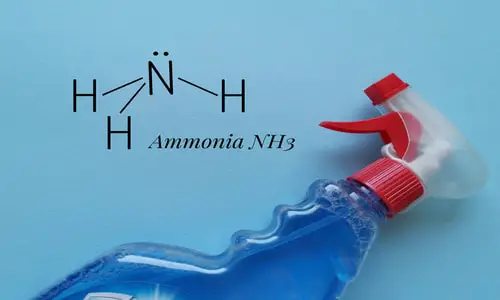If you are currently dealing with a mold infestation, you may have already tried several remedies to no avail, or you may have heard that ammonia will successfully kill mold and want to know if this is fact or fiction.
Ammonia’s efficacy in killing mold and mildew can be a tricky subject due to conflicting thoughts and opinions over the years. So, in this article, we will be taking a deep dive into the subject and leaving no stone unturned.
So, to get the most comprehensive answer to the question “Will ammonia kill mold?”, keep reading.

What is ammonia?
Ammonia is a chemical compound consisting of nitrogen and hydrogen and has a chemical symbol of NH3. It is a colorless gas that can be dissolved into water to create ammonia hydroxide. The chemical has a pungent smell is highly irritating to the skin and lungs and can be fatal if ingested or inhaled.
Ammonia is used in the production of fertilizers, plastics, synthetic fibers, explosives, cleaning and pharmaceutical products.
Does ammonia kill mold?
Considering that ammonia is clearly a very powerful chemical, you may be surprised to learn that it can, indeed kill mold, however, only under certain circumstances.
Due to the corrosive nature of ammonia hydroxide, it has the ability to break down the mold, effectively dissolving it.
The main issue with using this chemical is that it can only kill mold and mildew on hard, non-porous surfaces such as tiles and countertops, as it is unable to penetrate deeper into porous materials such as wood.
So if it were applied to any porous surface, the visible growth might be killed, only to have it return again. For growth on porous materials, other options such as distilled vinegar should be considered.
How to use ammonia to kill mold
Before we begin discussing how to use ammonia to kill mold, we need to make it very clear that this chemical is very potent and can be very hazardous to your health if not used correctly.
For these reasons, it is very important that you wear the correct safety equipment. The recommended PPE for using ammonia-based products is as follows:
- Eye goggles
- Rubber gloves
- Respirator
Bear in mind that ammonia can cause burns to the skin, so covering up as much as possible acts as an additional layer of protection.
As you will be using a spray bottle, some ammonia molecules will travel through the air, so open up windows and doors to allow as much ventilation as possible. If available, have a fan running in the room to add additional ventilation.
Once you have the correct safety gear on and have set up your area to work in, you are ready to begin. To kill mold and mildew with ammonia, use the following steps.
Step 1. Make a solution of household ammonia and distilled water as described on the container it comes in. You must use distilled water as it contains no chlorine.
Step 2. Pour this solution into a spray bottle and spray the affected area liberally.
Step 3. Leave the ammonia solution to work for a minimum of two hours to give it time to kill the fungi.
Step 4. Using a clean cloth, wipe away the dead mold and any residue left behind. To lessen the pungent smell, you can wipe the walls down with tap water. The smell should dissipate within a few hours.
Does ammonia remove mold from clothes?
Ammonia is just as effective at killing mold on clothes and materials as it is at killing it on hard surfaces. However, due to the potential for chemical reactions, it is not advised to mix household tap water with ammonia, as the chlorine in it can interact with the ammonia and create chloramines, a type of toxic gas.
There is the option of using distilled water mixed with ammonia to kill the mold you’ve found on fabrics or clothes, but this is obviously a more expensive method.
Household detergents are more than adequate for killing and removing mold from fabrics, so these should be your go-to method.
Can ammonia kill mold on these materials?
Despite ammonia being a powerful chemical that can kill mold, it may not be as effective on certain types of materials. This is because it does not get deep into the materials and cannot kill the underlying mold growth.
Wood
When it comes to the efficacy of ammonia in killing mold on wood, whether the material has been treated or not plays a big part in the equation.
Some treated woods can be waterproofed, as is the case with some varnishes and lacquers. In this instance, ammonia will be able to kill mold that is present on the surface, as it is likely to only be superficial growth that does not penetrate deeper.
However, untreated wood is a different story, as the fungi can grow deep down into the area of the wood beneath its surface and so cannot be reached by the ammonia.
In this instance, other liquids such as distilled vinegar would be a more efficient way of killing it.
Concrete
You might be surprised to hear that despite the fact that concrete is a very strong building material, it is very porous. In fact, the pores make up between 12-18% of the material, but cannot be seen.
This makes ammonia an ineffective method of mold removal. Alternatives should be looked into, such as vinegar or other specific mold-killing products.
Walls
Walls that have been treated with primers and sealers create a hydrophobic layer on the surface of the wall, meaning that just like with treated wood, only surface-level mold can grow. In this instance, ammonia would be an effective mold removal method.
Many walls are not treated in this way though, and untreated brickwork or drywall are very porous materials, making ammonia an ineffective method of remediation.
Carpet
Mold growth on a carpet can be difficult to treat, as it is often only discovered once it has grown enough to be visible on the surface. In the majority of cases, the growth continues right down to the underlay and even the concrete below.
It is for these reasons that ammonia is not a good option for mold removal in carpets. It is also a corrosive substance that can damage the fibers and cause discoloration.
A more effective method would be to remove the carpet and treat any affected areas beneath it with distilled vinegar, replace any damaged underlay, and treat the carpet with either steam cleaners or specific mold-killing products.
How long does it take for ammonia to kill mold?
As ammonia is a powerful corrosive, it can kill mold relatively quickly. If applied directly to the growth on a nonporous surface, it will be able to kill it within 10-20 minutes. However, to be certain that all growth is halted, it is better to leave it to work for a minimum of 1-2 hours.
Is ammonia better for killing mold than bleach?
Both bleach and ammonia have a similar issue when dealing with mold growth, as neither of them is effective at treating fungi on porous materials. If these chemicals are used on growth that has occurred on a material such as untreated wood, some growth will remain and will begin to grow again shortly after the treatment has been completed.
On surface level growth, ammonia is superior to bleach at killing mold, as bleach will not always kill mold, but instead, only changes its color, hiding it from view.
Is it more effective than vinegar?
The acidity in vinegar and the combination of hydrogen and nitrogen in ammonia will both kill mold very effectively. The difference between these two liquids is that vinegar is vastly superior to ammonia in its overall mold-killing ability, as it has the ability to kill growth in porous materials, whereas ammonia cannot.
It also has the benefit of being far less corrosive and non-toxic, making it a lot safer to use.
Will ammonia kill black mold?
Yes, black mold may be more toxic than other strains, but it is made up of the same building blocks, and so will be killed just as effectively with ammonia.
It remains that this is only the case on nonporous materials, and lack mold growing on untreated walls for example would not be killed with ammonia and should be treated with vinegar or other specific mold-killing products.
Pros and cons of using ammonia
As with any product or method, there are pros and cons to using ammonia for mold remediation. To help outline these in a clear and concise way, I will list each below.
Pros
- Cheap
- Effective (on nonporous surfaces)
- Fast
- Easily available
Cons
- Highly toxic and can be fatal if used incorrectly
- Has a potent and unpleasant odour
- Requires high-quality protective equipment in order to be used
- Ineffective on porous materials
- Can turn into a toxic gas if mixed with other household cleaners
Conclusion
Ammonia is a powerful chemical that is used in cleaning and creating fertilizers. It can kill mold, but only on hard, non-porous surfaces. There are many other products that are just as effective (if not more) at killing mold and fungi and are significantly safer to use, such as distilled vinegar.

